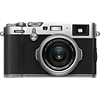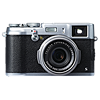Main
Model
Price
Advantages
launch
Announced
Body type
Camera subcategory
Sensor
Effective pixels
Max resolution
Sensor size
Sensor type
Processor
Image ratio w:h
Other resolutions
Image
ISO
Boosted ISO (minimum)
Boosted ISO (maximum)
White balance presets
Custom white balance
Image stabilization
Uncompressed format
JPEG quality levels
Photography features
Minimum shutter speed
Maximum shutter speed
Maximum shutter speed (electronic)
Aperture priority
Shutter priority
Manual exposure mode
Subject / scene modes
Built-in flash
Flash range
External flash
Flash modes
Continuous drive
Self-timer
Metering modes
Exposure compensation
AE Bracketing
WB Bracketing
Screen / viewfinder
Articulated LCD
Screen size
Screen dots
Touch screen
Screen type
Live view
Viewfinder type
Viewfinder coverage
Viewfinder magnification
Viewfinder resolution
Videography features
Resolutions
File Format
Microphone
Speaker
Optics & Focus
Focal length (equiv.)
Maximum aperture
Autofocus
Digital zoom
Manual focus
Normal focus range
Number of focus points
Optical zoom
Macro focus range
Physical
Weight (inc. batteries)
Dimensions
Environmentally sealed
Battery
Battery details
Battery Life (CIPA)
Storage
Storage types
Connectivity
USB
HDMI
Microphone port
Headphone port
Wireless
Wireless notes
Remote control
Other features
Orientation sensor
Timelapse recording
GPS
Samples
Videos
Summary
The Fujifilm X100F maximum resolution of 6000 x 4000 pixels (24 megapixels) is better in comparison with the X100S maximum resolution of 4896 x 3264 pixels (16 megapixels). The X100S is equipped with bigger sensor compared to the Fujifilm X100F: APS-C (23.6 x 15.8 mm) versus APS-C (23.6 x 15.6 mm). This is the most significant specification of this model as large sensor lets you to produce pictures of the more professional quality. The Fujifilm X100F has a wider ISO range of 200-12800 than 200-6400 ISO range of the X100S. This ISO numbers let the camera owner to produce better pictures in more difficult situations. The Fujifilm X100F provides more focus points than the X100S: 325 vs 49. More focus points means less risk of losing focus lock while following a moving subject.
The Fujifilm X100F display is better as it offers more screen dots 1,040,000 in compare to 460,000 dots of the X100S screen. The higher dot count display is better for reviewing pictures on your camera. The X100S has better lowest (30 seconds) and fastest (1/4000 second) shutter speeds.
The X100F is equipped with built-in Wi-Fi that will help the camera owner to transfer pictures quick and easy. The Fujifilm X100F battery life is better in compare to the X100S battery life. In accordance with CIPA standards the photographer will be able to produce 390 shots with the X100F and only 330 with the X100S. The X100S weighs 445g that is 24g less in comparison with the weight of the X100F.
The Fujifilm X100F has 12 advantages and the X100S only 4 so the X100F is the best choice. Get the list of the best offers on Amazon.


